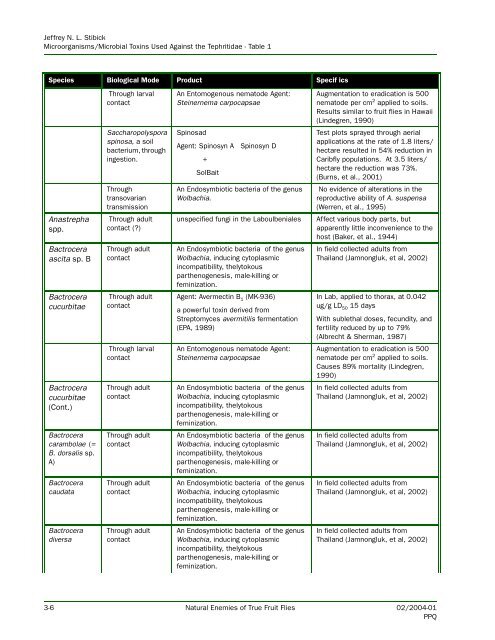Natural Enemies of True Fruit Flies (Tephritidae) - USDA - aphis
Natural Enemies of True Fruit Flies (Tephritidae) - USDA - aphis
Natural Enemies of True Fruit Flies (Tephritidae) - USDA - aphis
Create successful ePaper yourself
Turn your PDF publications into a flip-book with our unique Google optimized e-Paper software.
Jeffrey N. L. Stibick<br />
Microorganisms/Microbial Toxins Used Against the <strong>Tephritidae</strong> - Table 1<br />
Species Biological Mode Product Specif ics<br />
Anastrepha<br />
spp.<br />
Bactrocera<br />
ascita sp. B<br />
Bactrocera<br />
cucurbitae<br />
Bactrocera<br />
cucurbitae<br />
(Cont.)<br />
Bactrocera<br />
carambolae (=<br />
B. dorsalis sp.<br />
A)<br />
Bactrocera<br />
caudata<br />
Bactrocera<br />
diversa<br />
Through larval<br />
contact<br />
Saccharopolyspora<br />
spinosa, a soil<br />
bacterium, through<br />
ingestion.<br />
Through<br />
transovarian<br />
transmission<br />
Through adult<br />
contact (?)<br />
Through adult<br />
contact<br />
Through adult<br />
contact<br />
Through larval<br />
contact<br />
Through adult<br />
contact<br />
Through adult<br />
contact<br />
Through adult<br />
contact<br />
Through adult<br />
contact<br />
An Entomogenous nematode Agent:<br />
Steinernema carpocapsae<br />
Spinosad<br />
Agent: Spinosyn A Spinosyn D<br />
+<br />
SolBait<br />
An Endosymbiotic bacteria <strong>of</strong> the genus<br />
Wolbachia.<br />
Augmentation to eradication is 500<br />
nematode per cm 2 applied to soils.<br />
Results similar to fruit flies in Hawaii<br />
(Lindegren, 1990)<br />
Test plots sprayed through aerial<br />
applications at the rate <strong>of</strong> 1.8 liters/<br />
hectare resulted in 54% reduction in<br />
Caribfly populations. At 3.5 liters/<br />
hectare the reduction was 73%.<br />
(Burns, et al., 2001)<br />
No evidence <strong>of</strong> alterations in the<br />
reproductive ability <strong>of</strong> A. suspensa<br />
(Werren, et al., 1995)<br />
unspecified fungi in the Laboulbeniales Affect various body parts, but<br />
apparently little inconvenience to the<br />
host (Baker, et al., 1944)<br />
An Endosymbiotic bacteria <strong>of</strong> the genus<br />
Wolbachia, inducing cytoplasmic<br />
incompatibility, thelytokous<br />
parthenogenesis, male-killing or<br />
feminization.<br />
Agent: Avermectin B1 (MK-936)<br />
a powerful toxin derived from<br />
Streptomyces avermitilis fermentation<br />
(EPA, 1989)<br />
An Entomogenous nematode Agent:<br />
Steinernema carpocapsae<br />
An Endosymbiotic bacteria <strong>of</strong> the genus<br />
Wolbachia, inducing cytoplasmic<br />
incompatibility, thelytokous<br />
parthenogenesis, male-killing or<br />
feminization.<br />
An Endosymbiotic bacteria <strong>of</strong> the genus<br />
Wolbachia, inducing cytoplasmic<br />
incompatibility, thelytokous<br />
parthenogenesis, male-killing or<br />
feminization.<br />
An Endosymbiotic bacteria <strong>of</strong> the genus<br />
Wolbachia, inducing cytoplasmic<br />
incompatibility, thelytokous<br />
parthenogenesis, male-killing or<br />
feminization.<br />
An Endosymbiotic bacteria <strong>of</strong> the genus<br />
Wolbachia, inducing cytoplasmic<br />
incompatibility, thelytokous<br />
parthenogenesis, male-killing or<br />
feminization.<br />
In field collected adults from<br />
Thailand (Jamnongluk, et al, 2002)<br />
In Lab, applied to thorax, at 0.042<br />
ug/g LD 50 15 days<br />
With sublethal doses, fecundity, and<br />
fertility reduced by up to 79%<br />
(Albrecht & Sherman, 1987)<br />
Augmentation to eradication is 500<br />
nematode per cm 2 applied to soils.<br />
Causes 89% mortality (Lindegren,<br />
1990)<br />
In field collected adults from<br />
Thailand (Jamnongluk, et al, 2002)<br />
In field collected adults from<br />
Thailand (Jamnongluk, et al, 2002)<br />
In field collected adults from<br />
Thailand (Jamnongluk, et al, 2002)<br />
In field collected adults from<br />
Thailand (Jamnongluk, et al, 2002)<br />
3-6 <strong>Natural</strong> <strong>Enemies</strong> <strong>of</strong> <strong>True</strong> <strong>Fruit</strong> <strong>Flies</strong> 02/2004-01<br />
PPQ

















